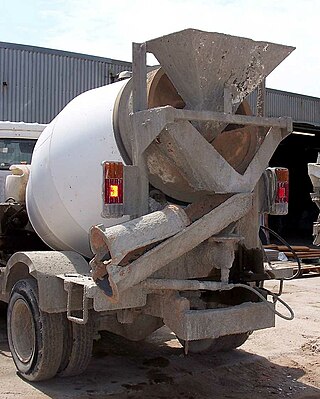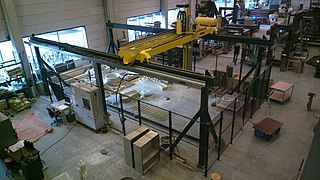Related Research Articles

Concrete is a composite material composed of aggregate bonded together with a fluid cement that cures over time. Concrete is the second-most-used substance in the world after water, and is the most widely used building material. Its usage worldwide, ton for ton, is twice that of steel, wood, plastics, and aluminium combined.

A cement is a binder, a chemical substance used for construction that sets, hardens, and adheres to other materials to bind them together. Cement is seldom used on its own, but rather to bind sand and gravel (aggregate) together. Cement mixed with fine aggregate produces mortar for masonry, or with sand and gravel, produces concrete. Concrete is the most widely used material in existence and is behind only water as the planet's most-consumed resource.

Portland cement is the most common type of cement in general use around the world as a basic ingredient of concrete, mortar, stucco, and non-specialty grout. It was developed from other types of hydraulic lime in England in the early 19th century by Joseph Aspdin, and is usually made from limestone. It is a fine powder, produced by heating limestone and clay minerals in a kiln to form clinker, grinding the clinker, and adding 2 to 3 percent of gypsum. Several types of portland cement are available. The most common, called ordinary portland cement (OPC), is grey, but white Portland cement is also available. Its name is derived from its resemblance to portland stone which was quarried on the Isle of Portland in Dorset, England. It was named by Joseph Aspdin who obtained a patent for it in 1824. His son William Aspdin is regarded as the inventor of "modern" portland cement due to his developments in the 1840s. The term portland in this context refers to a material or process, not a proper noun like a place or a person, and should not be capitalized.

Ready-mix concrete (RMC) is concrete that is manufactured in a batch plant, according to each specific job requirement, then delivered to the job site "ready to use".
Engineered Cementitious Composite (ECC), also called Strain Hardening Cement-based Composites (SHCC) or more popularly as bendable concrete, is an easily molded mortar-based composite reinforced with specially selected short random fibers, usually polymer fibers. Unlike regular concrete, ECC has a tensile strain capacity in the range of 3–7%, compared to 0.01% for ordinary portland cement (OPC) paste, mortar or concrete. ECC therefore acts more like a ductile metal material rather than a brittle glass material, leading to a wide variety of applications.
The water–cement ratio is the ratio of the mass of water to the mass of cement used in a concrete mix:
Metakaolin is the anhydrous calcined form of the clay mineral kaolinite. Minerals that are rich in kaolinite are known as china clay or kaolin, traditionally used in the manufacture of porcelain. The particle size of metakaolin is smaller than cement particles, but not as fine as silica fume.
Nanotechnology is impacting the field of consumer goods, several products that incorporate nanomaterials are already in a variety of items; many of which people do not even realize contain nanoparticles, products with novel functions ranging from easy-to-clean to scratch-resistant. Examples of that car bumpers are made lighter, clothing is more stain repellant, sunscreen is more radiation resistant, synthetic bones are stronger, cell phone screens are lighter weight, glass packaging for drinks leads to a longer shelf-life, and balls for various sports are made more durable. Using nanotech, in the mid-term modern textiles will become "smart", through embedded "wearable electronics", such novel products have also a promising potential especially in the field of cosmetics, and has numerous potential applications in heavy industry. Nanotechnology is predicted to be a main driver of technology and business in this century and holds the promise of higher performance materials, intelligent systems and new production methods with significant impact for all aspects of society.

Pozzolans are a broad class of siliceous and aluminous materials which, in themselves, possess little or no cementitious value but which will, in finely divided form and in the presence of water, react chemically with calcium hydroxide (Ca(OH)2) at ordinary temperature to form compounds possessing cementitious properties. The quantification of the capacity of a pozzolan to react with calcium hydroxide and water is given by measuring its pozzolanic activity. Pozzolana are naturally occurring pozzolans of volcanic origin.
Geopolymers are inorganic, typically ceramic, alumino-silicate forming long-range, covalently bonded, non-crystalline (amorphous) networks. Obsidian fragments are a component of some geopolymer blends. Commercially produced geopolymers may be used for fire- and heat-resistant coatings and adhesives, medicinal applications, high-temperature ceramics, new binders for fire-resistant fiber composites, toxic and radioactive waste encapsulation and new cements for concrete. The properties and uses of geopolymers are being explored in many scientific and industrial disciplines: modern inorganic chemistry, physical chemistry, colloid chemistry, mineralogy, geology, and in other types of engineering process technologies. The field of geopolymers is a part of polymer science, chemistry and technology that forms one of the major areas of materials science.
Calcium silicate hydrates are the main products of the hydration of Portland cement and are primarily responsible for the strength of cement-based materials. They are the main binding phase in most concrete. Only well defined and rare natural crystalline minerals can be abbreviated as CSH while extremely variable and poorly ordered phases without well defined stoichiometry, as it is commonly observed in hardened cement paste (HCP), are denoted C-S-H.

Concrete is produced in a variety of compositions, finishes and performance characteristics to meet a wide range of needs.

Geopolymer cement is a binding system that hardens at room temperature.

Energetically modified cements (EMCs) are a class of cements made from pozzolans, silica sand, blast furnace slag, or Portland cement. The term "energetically modified" arises by virtue of the mechanochemistry process applied to the raw material, more accurately classified as "high energy ball milling" (HEBM). This causes, amongst others, a thermodynamic transformation in the material to increase its chemical reactivity. For EMCs, the HEBM process used is a unique form of specialised vibratory milling discovered in Sweden and applied only to cementitious materials, here called "EMC Activation".
Limestone Calcined Clay Cement (LC3) is a low-carbon cement developed by the École Polytechnique Fédérale de Lausanne (EPFL), Indian Institute of Technology (IIT) Delhi, IIT-Bombay, Technology and Action for Rural Development (TARA), IIT-Madras, and the Central University of Las Villas (Cuba). The cement can reduce carbon dioxide emissions (CO2) related to manufacturing by 30% as compared to ordinary Portland cement. In 2014, the LC3 project received 4m CHF in Research and Development funding from the Swiss Agency for Development and Cooperation (SDC).

Karen Louise Scrivener is a material chemist known for her pioneering works in cementitious materials. She is the head of Laboratory of Construction Materials at Ecole Polytechnique Fédérale de Lausanne and served as the editor-in-chief of the Cement and Concrete Research journal for 15 years.
Franz-Josef Ulm is a structural engineer, an engineering scientist and a professor since 1999. He is Professor of Civil & Environmental Engineering at the Massachusetts Institute of Technology (MIT), the Faculty Director of the Concrete Sustainability Hub (CSHub@MIT). He is credited for discovering the nanogranular structure of Calcium-Silicate-Hydrates (C-S-H), the binding phase of concrete, and for the development of concepts of nanoengineering of concrete which combine advanced nanomechanics experiments with molecular simulation results. He speaks up for an environmental sustainable engineering, with “greener” concrete with lower CO2 footprint, to reduce the carbon footprint of concrete; to enhance concrete's resilience; and reduce its impact on global warming.

Nanoconcrete is a form of concrete that contains Portland cement particles that are no greater than 100 μm and particles of silica no greater than 500 μm, which fill voids that would otherwise occur in normal concrete, thereby substantially increasing the material's strength. It is also a product of high-energy mixing (HEM) of conventional cement, sand and water which is a bottom-up approach of nano technology.

Self-healing concrete is characterized as the capability of concrete to fix its cracks on its own autogenously or autonomously. It not only seals the cracks but also partially or entirely recovers the mechanical properties of the structural elements. This kind of concrete is also known as self-repairing concrete. Because concrete has a poor tensile strength compared to other building materials, it often develops cracks in the surface. These cracks reduce the durability of the concrete because they facilitate the flow of liquids and gases that may contain harmful compounds. If microcracks expand and reach the reinforcement, not only will the concrete itself be susceptible to attack, but so will the reinforcement steel bars. Therefore, it is essential to limit the crack's width and repair it as quickly as feasible. Self-healing concrete would not only make the material more sustainable, but it would also contribute to an increase in the service life of concrete structures and make the material more durable and environmentally friendly.

3D concrete printing, or simply concrete printing, refers to digital fabrication processes for cementitious materials based on one of several different 3D printing technologies. 3D printed concrete eliminates the need for formwork, reducing material waste and allowing for greater geometric freedom in complex structures. With recent developments in mix design and 3D printing technology over the last decade, 3D concrete printing has grown exponentially since its emergence in the 1990s. Architectural and structural applications of 3D-printed concrete include the production of building blocks, building modules, street furniture, pedestrian bridges, and low-rise residential structures.
References
- ↑ Scrivener, K. "Nanocem: An iterative process of dialogue." Archived 2016-06-10 at the Wayback Machine ZKG International 59.6. 2006.
- ↑ "Industrial competitors can share knowledge." Archived 2008-11-20 at the Wayback Machine Crescendo. April 2006.
- 1 2 "About Us." Archived 2016-05-19 at the Wayback Machine Nanocem. Accessed 18-5-16.
- ↑ Nalet, Camille (2016). Influence de la stéréochimie et de la fonctionnalité de molécules organiques sur l'hydratation de composés cimentaires.
- ↑ Giraudeau, Claire (2009). Interactions organo - aluminates dans les ciments. Intercalation de polyméthacrylates-g-PEO dans l'hydrocalumite.
- ↑ Berodier, Elise (2015). Impact of the supplementary cementitious materials on the kinetics and microstructural development of cement hydration. Thesis (Thesis). Archived from the original on 2019-01-31. Retrieved 2019-01-30.
- ↑ "Our Research." Archived 2016-05-03 at the Wayback Machine Nanocem. Accessed 4-4-17.
- ↑ Scrivener, K. "Nanotechnology and cementitious materials." Nanotechnology in Construction 3. Eds. Bittnar, Z., Bartos, P.J.M., Nemecek, J., Smilauer, V., Zeman, J. Springer-Verlag Berlin Heidelberg, 2009. pp. 37-42.
- ↑ Hao, X.H., Zhang, A.Q., Yang, W. "Study on the Performance of Nano Calcium Carbonate Modified Asphalt Concrete AC-13" Archived 2016-06-10 at the Wayback Machine . Advanced Materials Research 450.2: 503-07. 2012.
- ↑ Scrivener, K. L. "Importance of Microstructural Understanding for Durable and Sustainable Concrete." Concrete Repair, Rehabilitation and Retrofitting. Eds. Mark G. Alexander, Hans-Dieter Beushausen, Frank Dehn, Pilate Moyo. CRC Press, 2008. pp. 11-17. Accessed via Google Books 18-5-16.
- ↑ Li, Z. Advanced Concrete Technology. John Wiley & Sons, 2011. Accessed via Google Books 18-5-16.
- ↑ Birgisson, B., Taylor, P., Armaghani, J., Shah, S. "American road map for research for nanotechnology-based concrete materials." Transportation Research Record: Journal of the Transportation Research Board 2142. 2010.
- ↑ "Our Publications". Archived 2016-06-11 at the Wayback Machine Nanocem. Accessed 4-4-17.
- ↑ Mulot, R. “Pour faire sa révolution, le béton fait appel aux nanosciences” Archived 2016-06-24 at the Wayback Machine . Sciences et Avenir. 16 October 2008.
- ↑ "vdz ggmbh home". Archived from the original on 2017-04-05. Retrieved 2017-04-04.
- ↑ "Nanocem - Partners". Archived from the original on 2018-04-16. Retrieved 2018-04-16.
- ↑ "CRH what we do". Archived from the original on 2017-04-21. Retrieved 2017-04-04.